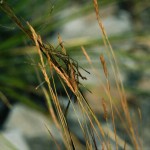Tanglehead
Heteropogon contortus (L.) P. Beauv. ex Roem. & Schult.
Poaceae
Description
This bunchgrass grows in erect tufts and may form large bunches. The round reproductive shoot emerges from a flattened base. Sheaths are flat and overlapping. Florets are 2 to 4 inches or 5 to 10 cm long, brown, fuzzy, and twisted. Spikelets overlap, and each fertile one has a single reddish-brown awn that can be 4 inches long, with two bends. The long-awned seeds have a sharp point, and the awns form a tangled mass as they mature. At maturity, the foliage turns reddish brown, with yellow straw stems, and tastes like molasses. Tanglehead is a perennial, warm-season, native grass ranging from 12 to 42 inches or 30 to 107 cm tall. Good grazing for livestock. Poor forage for wildlife. Tanglehead can be harvested for hay bales but may spread seeds to feeding sites.Habitat
Grows on rocky hills, ridges, and along railroad right-of-ways. In Texas, it can be found in sandy prairies, within coastal regions, in the Trans-Pecos mountainous areas, and is known to persist in well-managed pasturelands. Tanglehead is adapted to survive in areas that receive low amounts of precipitation and sites with low soil fertility.Images
Plant Characteristics
Seed Type: Non-Encapsulated
Duration: Perennial
Stem Texture: Hairless/Smooth
Growth Habit: Bunch grass, Grasses
Leaf Shape
 : Simple with Pinnate or Parallel Venation
: Simple with Pinnate or Parallel Venation
Season: Warm
Distribution
 : 01 - Pineywoods, 02 - Gulf Prairies and Marshes, 05 - Cross Timbers and Prairies, 06 - South Texas Plains, 07 - Edwards Plateau, 10 - Trans-Pecos
: 01 - Pineywoods, 02 - Gulf Prairies and Marshes, 05 - Cross Timbers and Prairies, 06 - South Texas Plains, 07 - Edwards Plateau, 10 - Trans-Pecos
Distributions
Distribution refers to the ecological region in Texas that a plant has been found. You can also view a clickable map.
Book: Know Your Grasses (B-182)
Collection: Grasses


